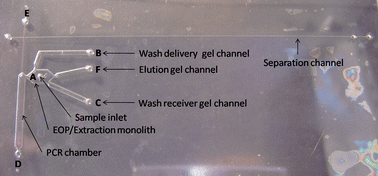Development of a bi-functional silica monolith for electro-osmotic pumping and DNA clean-up/extraction using gel-supported reagents in a microfluidic device
Abstract
A

* Corresponding authors
a
Department of Chemistry, The University of Hull, Cottingham Road, Kingston upon Hull, UK
Fax: +01482 466410
Tel: +01482 465475
b
Postgraduate Medical Institute, The University of Hull, Cottingham Road, Kingston upon Hull, UK
E-mail:
S.J.Haswell@hull.ac.uk
Fax: +01482 466410
Tel: +01482 465469
A

 Please wait while we load your content...
Something went wrong. Try again?
Please wait while we load your content...
Something went wrong. Try again?
J. A. Oakley, K. J. Shaw, P. T. Docker, C. E. Dyer, J. Greenman, G. M. Greenway and S. J. Haswell, Lab Chip, 2009, 9, 1596 DOI: 10.1039/B820553A
To request permission to reproduce material from this article, please go to the Copyright Clearance Center request page.
If you are an author contributing to an RSC publication, you do not need to request permission provided correct acknowledgement is given.
If you are the author of this article, you do not need to request permission to reproduce figures and diagrams provided correct acknowledgement is given. If you want to reproduce the whole article in a third-party publication (excluding your thesis/dissertation for which permission is not required) please go to the Copyright Clearance Center request page.
Read more about how to correctly acknowledge RSC content.
 Fetching data from CrossRef.
Fetching data from CrossRef.
This may take some time to load.
Loading related content
